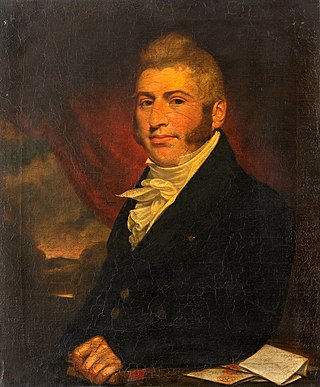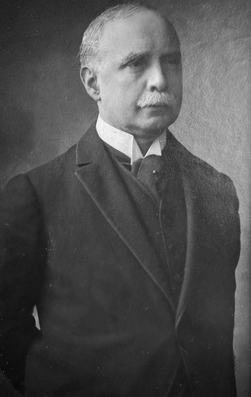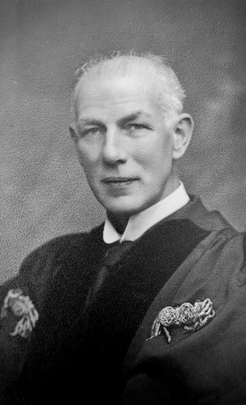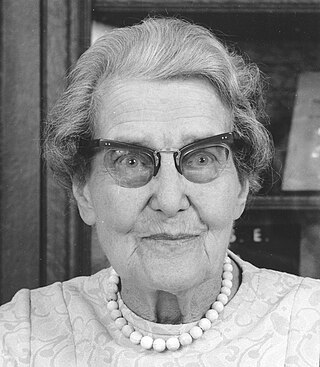Related Research Articles

John Abercrombie was a Scottish physician, author, philosopher and philanthropist. His Edinburgh practice became one of the most successful medical practices in Scotland. The Chambers Biographical Dictionary says of him that after James Gregory's death, he was "recognized as the first consulting physician in Scotland". As surgeon to The Royal Public Dispensary and the New Town Dispensary he provided free medical care for the poor of the town and taught medical students and apprentices. He published extensively on medical topics and latterly on metaphysics morality and religion. A devout Christian he gave financial support to missionary work. Abercrombie was awarded the honorary degree of MD from the University of Oxford, was elected Rector of Marischal College and University, Aberdeen and appointed Physician to the King in Scotland.

William Cullen was a Scottish physician, chemist and agriculturalist, and professor at the Edinburgh Medical School. Cullen was a central figure in the Scottish Enlightenment: He was David Hume's physician, and was friends with Joseph Black, Henry Home, Adam Ferguson, John Millar, and Adam Smith, among others.

Neuropathology is the study of disease of nervous system tissue, usually in the form of either small surgical biopsies or whole-body autopsies. Neuropathologists usually work in a department of anatomic pathology, but work closely with the clinical disciplines of neurology, and neurosurgery, which often depend on neuropathology for a diagnosis. Neuropathology also relates to forensic pathology because brain disease or brain injury can be related to cause of death. Neuropathology should not be confused with neuropathy, which refers to disorders of the nerves themselves rather than the tissues. In neuropathology, the branches of the specializations of nervous system as well as the tissues come together into one field of study.

Prof Arthur Gamgee FRS FRSE was a British biochemist.

Mary Broadfoot Walker was a Scottish physician who first demonstrated the effectiveness of physostigmine in the treatment of the condition myasthenia gravis, a disease relating to muscle weakness. She was also the first to recognise the association between familial periodic paralysis and low blood potassium levels.

Sir Thomas Grainger Stewart was an eminent Scottish physician who served as president of the Royal College of Physicians of Edinburgh (1889–1891), president of the Medico-Chirurgical Society of Edinburgh, president of the medicine section of the British Medical Association, and Physician-in-Ordinary to the Queen for Scotland. He was perhaps best known for describing the condition known as multiple neuritis as well as directing scientific attention in Great Britain to the deep reflexes.

George Carmichael Low was a Scottish parasitologist.
James Taylor, CBE, FRCP was a British neurologist.

Isabel Galloway Emslie, Lady Hutton CBE was a Scottish physician who specialised in mental health and social work.

Sir Robert William Philip was a Scottish physician and pioneer in the treatment and control of tuberculosis.

Dawson Fyers Duckworth Turner, FRSE, FRCPE (1857–1928) was a British pioneer of radiology and patron of the arts, who died of radiation related cancer.

David Malcolm Murray Lyon FRSE DPH (1888-1956) was an English physician and medical author. He was president of the Royal College of Physicians of Edinburgh from 1945–47, and was editor of the Edinburgh Medical Journal.
Sir Douglas Vernon Hubble was a paediatric endocrinologist, general practitioner, and professor of paediatrics and dean of medicine at the University of Birmingham. Hubble was principally notable for research into paediatric endocrinology and publishing a number of papers on the subject, which gave him a national reputation.

Joseph Godwin Greenfield, was an early neuropathologist. He created, with 28 founding members, the neuropathological club, which would eventually become the British Neuropathological Society. Greenfield served as pathologist at the National Hospital for Neurology and Neurosurgery at Queen Square.

William Russell FRCPE was a Scottish pathologist and physician who became Professor of Medicine at the University of Edinburgh and president of the Royal College of Physicians of Edinburgh. He was the first to describe the cellular inclusion particles known as Russell bodies. He was an early supporter of medical education for women.
Dame Ingrid Victoria Allen, was Professor Emerita of Neuropathology at Queen's University Belfast. She is mostly known for her research in pathology, neurodegeneration, neurovirology and demyelinating diseases, such as multiple sclerosis.

Sir Norman Purvis Walker FRCPE was a Scottish dermatologist, and physician-in-charge of the Skin Department at the Royal Infirmary of Edinburgh. He was also one of the first persons in Britain to benefit from the discovery of insulin as a treatment for diabetes.

Edith Kate Dawson MBE FRCSEd FRCPEd (1886–1983) was a pathologist who received a DSc for a thesis on sarcoma in 1970 and an MBE in 1968. Dawson carried out her research at both the Royal College of Surgeons of Edinburgh and the Royal College of Physicians of Edinburgh.
James Leatham Birley (1884–1934) was a British physician and neurologist, known for his work on fatigue and stress in WWI pilots.

John William Struthers FRCSEd was a Scottish surgeon. During World War I he served as a major in the Royal Army Medical Corps and was awarded the Serbian Order of St Sava. During his career in Edinburgh he became an early user of local anaesthetic techniques in general surgery and wrote a highly regarded booklet on the topic. He was elected President of the Royal College of Surgeons of Edinburgh (RCSEd) from 1941 to 1943.
References
- 1 2 T.J. Murray. Multiple Sclerosis: The History of a Disease, page 190. Demos Medical Publishing LLC, 2005. ISBN 978-1-888799-80-4.
- ↑ "James Walker Dawson, M.D., D.Sc., F.R.C.P.E., F.R.C.S.E." Br Med J. 2 (3471): 116–117. July 1927. doi:10.1136/bmj.2.3471.116-c. PMC 2524459 . PMID 20773303.
- ↑ Dawson, James (1907). "Some problems in relation to the healing of wounds".
{{cite journal}}: Cite journal requires|journal=(help) - ↑ Dawson JD. The Histology of Disseminated Sclerosis. Trans Royal Soc Edin. 1916; 50: 517-740.
- ↑ J. W. Dawson: The spirit of leisure and the spirit of work. Edinburgh Medical Journal, January 1924.
- ↑ Dawson, Edith Kate MA MD FRCSEd. The Royal College of Surgeons of Edinburgh Collected Papers.